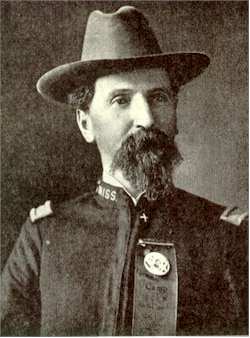|
The Raymond Fencibles “O
ye, in silent, comradeship asleep, in the long bivouac of the martyred
dead, Part II
Officers elected to lead the Raymond Fencibles were: Samuel Beauchamp Thomas, Captain; John McLean, Captain; Joseph Johnson, 1st Lieutenant; William Thomas, 2nd Lieutenant; Beauchamp Thomas, 3rd Lieutenant; Sedley Bracey, 1st Sgt.; Robert Hunter, 2nd Sgt.; Robert Herring, 3rd Sgt.; Michael Burke, 4th Sgt.; Robert Hall, 5th Sgt.; Joseph Bradley, 1st Corp.; Warren Jennings, 2nd Corp.; Samuel Shelton, 3rd Corp. and John Clary, Corp. Approximately 113 men enlisted as privates. On March 13, 1861, the Raymond Fencibles officially organized and marched to Corinth, where they joined the 12th Mississippi Infantry Regiment. Thomas Gregory Dabney, a recruit with the Raymond Fencibles, described the mood of the men saying, “The 12th Mississippi was then full twelve-hundred strong of light hearted men.” However, the jovial spirit was short-lived. Before the Raymond Fencibles could engage in their first battle at Seven Pines, Virginia, at least 20 of the men had been given honorable discharges and sent home due to illness. Another dozen died before they could be sent home. By 1862, the roster of the Raymond Fencibles had been drastically reduced. Enlisted with the Raymond Fencibles were six men whose obituaries were recorded in the Confederate Veteran Magazine or whose families preserved their service record: William A. Montgomery, Confederate Scout, Edwards; Thomas Gregory Dabney, 17-year-old son of Augustine Dabney, Raymond; Honorable Samuel Shelton, nephew of Raymond attorney, John Shelton; and Dr. A. A. Bracey, son of a plantation owner. Other soldiers fighting with the Raymond Fencibles were Cade Drue Gillespie and his brother Robert Gillespie. Thomas Gregory Dabney was one of the youngest to enroll in the Raymond Fencibles. His father, Augustine Dabney, was a probate judge in Raymond. In 1862, as the battles raged in Virginia, Thomas Dabney was honorably discharged being “under age.” He returned to Raymond and later re-enlisted with another regiment in the Western Army and spent the final years of the war at Fort Blakley, Mobile Bay. William Montgomery, age 16, was the son of Olivia Moore and Charles Montgomery of Edwards. “He was a student at Union College, Murfreesboro, Tenn., when the war commenced,” stated the facts in his obituary. “He was ordered home by his father when the state of Mississippi seceded from the Union, and was among the first volunteers from Mississippi, notwithstanding his father’s protest on account of his youth.” He was honorably discharged Dec. 28, 1861 because of illness and returned to Mississippi where he joined the cavalry command of General Wirt Adams. After the Battle of Champion’s Hill, he was promoted to chief of scouts and later to captain of Montgomery Scouts. Montgomery’s lengthy diary details his war experiences. Samuel Shelton, student at Hampden-Sidney College, Virginia, came to Mississippi in September of 1859, to live with his uncle, Attorney John Shelton. Under his uncle’s guidance, Samuel Shelton studied to become a lawyer. When the war broke out, he enlisted with the Raymond Fencibles. Shelton fought in the Seven Days’ Battle before Richmond, Second Manassas, Sharpsburg, and Fredericksburg. After Fredericksburg, he was transferred to the 44th Virginia and fought in the battles of Chancellorsville, Gettysburg , the Wilderness and Spottsylvania. After the war, he returned home to his wife, Imogene Gray of Raymond, and opened a law practice in Vicksburg. Dr. Augustine A. Bracey, son of a wealthy plantation owner near Raymond, was a graduate of Franklin College, Franklin, Louisiana. Like Private Shelton, Augustine fought through all of the war. His obituary states, “He enlisted in the Raymond Fencibles which became Company A, 12th Mississippi Regiment, Harris’s Brigade, A.N.V. This brigade was engaged in all of the principal fights from Bull Run to Appomattox. In the battle of Gettysburg, General Lee left Comrade Bracey on a post of observation. He remained there until the army had made quite a march toward Virginia. He did not overtake it for four days after the battle. His regiment was almost wiped out of existence at Gettysburg.” Following the war, Bracey returned to Raymond and married Annie Hutchins, daughter of Col. Thomas Hutchins. Cade Drue Gillespie, son of a prominent Raymond family, enlisted with the Raymond Fencibles, as did his brother, Robert J. Gillespie. Cade Gillespie was wounded in the leg at the Battle of Frazier’s Farm, June 30, 1862. After recovering from his wounds, he rejoined the regiment. His brother, Robert, was captured August 21, 1864, at Weldon Roads. After the war, Cade Gillespie returned to Raymond where he met and married Carrie Blanche Johnson and established a law practice. During the course of the war, the Raymond Fencibles, fighting along with the 12th Mississippi Infantry, was decimated. Over 20 of the men were listed “killed in battle.” Others were captured, wounded or served time in northern prisons. On April 12, 1865, when the South surrendered, the decimation of the Raymond Fencibles was obvious when only five soldiers were present at the surrender: Privates J. T. Lancaster, John Miller, P. A. Mullen, John Napp and O. H. Spence. Another soldier, Private Erasmus McRaven, was on furlough in Mississippi at the time of the surrender. Historic sources from Confederate Veteran Magazines. The roster of the Hinds County soldiers who enlisted with the Raymond Fencibles can be found at http://www.homestead.com/rebelyell/RaymondFencibles.html
|
||
|
© 2003-2005, all rights reserved |
